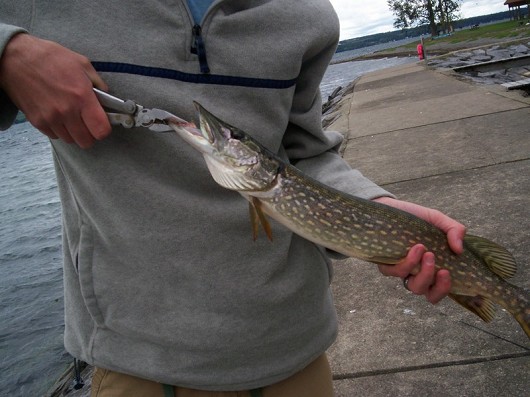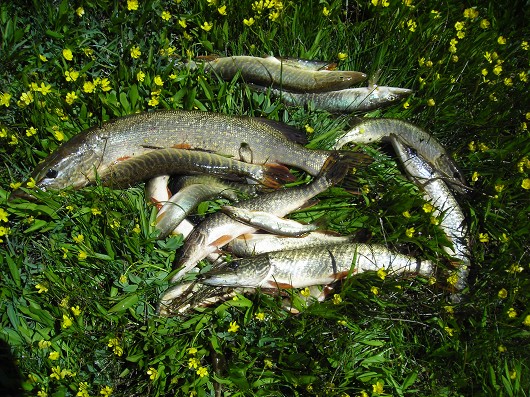Northern Pike
-
Scientific NameEsox lucius
-
NativeNon-Native
-
Identification
 Northern pike, captured from Lake Davis, CA. Photo by Robert Vincik, California Department of Fish and Game.
Northern pike, captured from Lake Davis, CA. Photo by Robert Vincik, California Department of Fish and Game. Northern Pike caught in Seneca Lake, New York in September 2007. Photo by Arthur Masloski.
Northern Pike caught in Seneca Lake, New York in September 2007. Photo by Arthur Masloski. Northern pike (group), captured from Lake Davis, CA. Photo by Robert Vincik, California Department of Fish and Game.
Northern pike (group), captured from Lake Davis, CA. Photo by Robert Vincik, California Department of Fish and Game.- Elongate, cylindrical, body with a strongly flattened snout half the length of the head
- Mouth lined with sharp teeth and extending past the middle of the eye
- Lower jaw extends past upper and contains large canine-like teeth
- 105-148 fine cycloid scales on the lateral line
- Slimy while alive
- Forked tail
- 15-19 dorsal, 12-15 anal, 14-17 pectoral, and 10-11 pelvic fin rays
- Dark olive or grey on back and sides with a white to yellow belly, and typically rows of light oval spots on the side and head
- Paired fins are normally tinged orange, and median fins commonly contain black splotches
- Juveniles often have dark oblique lines running down their side
-
Life History
Northern Pike are commonly found in a variety of habitats including cool clear lakes, sluggish streams, and river backwaters, provided they have abundant shallow water (less than 4 m) and large amounts of vegetation growth. As they get older and larger northern pike will move towards the edges of the vegetation beds and into deeper water. This movement brings with it a drop in temperature down to as low as 1-4°C. The species’ lethal maximum temperature is believed to be 28-30°C. They are most common in freshwater areas but northern pike are capable of living in salinities as high as 10 ppt and breeding in areas up to 7 ppt.
Outside of breeding times northern pike are solitary creatures that patrol non-territorial home ranges for food. The northern pike is a sight-based, ambush hunter, taking advantage of clear water and thick vegetation to see and hide from its prey respectively. When prey passes in front of its hiding spot the northern pike will shoot forward, propelled by both its strong fins and a stream of water squeezed from its bucchal cavity, catching its target in its protruding jaws. In order to further disguise themselves, northern pike will defecate outside of their ranges in order to minimize the presence of fear scent that certain prey species have evolved to avoid. The type of prey pursued changes with the northern pike’s size. Fry will hunt mostly zooplankton, amphipods, and increasingly large benthic invertebrate larvae. By the time northern pike reach 25 cm, other fish, especially soft-rayed fish, make up the majority of their diet. Despite this preference, the northern pike is an opportunistic species, and frogs, snakes, mammals, and birds have all been found in northern pike stomachs.
Pike will mature in their second to third year when they are between 30 cm and 50 cm in length. Spawning occurs between February and April, when temperatures are between 5°C and 19°C. Shallow areas with dense vegetation beds are the preferred spawning location and some individuals will travel as much as 50 km to spawn in a suitable location. This search is aided by a homing ability that leads them to either their birthplace or locations where they have safely spawned before. Spawning may also occur in deeper areas if the near shore zone is too warm. Males arrive at spawning areas first and will rush in groups to court the females as they enter the area. A female will then release 5-60 eggs which are fertilized by the courting males as they fall before adhering to the vegetation below. Fecundity varies with size and age but in Lake Davis Reservoir, in the Feather River watershed, 3 year old females weighing 2.1-2.5 kg could produce between 30,000 and 80,000 eggs a season.
The embryos hatch in 12-14 days but the larvae stay attached to the plant body for another 4-15 days until they grow to approximately 10-12 mm and begin feeding within the spawning area. They will stay in this bed until they grow to approximately 20 cm, at which point they disperse by their own power or on the currents of increased stream flow. In their native ranges average growth rates put northern pike at 18 cm by their first year, 32 cm in their second, and 42 cm in their third, but California populations have consistently averaged higher growth rates (23 cm, 39 cm, and 53 cm in the first, second, and third years, respectively). Few individuals live past 10-12 years and 7 years old is a common maximum. The largest individual on record was a 29 year old Canadian fish that measured 110 cm and weighed 14.2 kg.
-
Links to Other ResearchN / A
-
WatershedN / A
Please note, watersheds are at the USGS 8-digit Hydrologic Unit Code (HUC) scale, so they often include a lot of sub-watersheds. If a species occurs in any sub-watershed within the HUC, the species appears within the HUC. Link to an EPA page that shows HUCs.


